【初中英语】英语九年级教案(全套教案) 人教版13
- 格式:doc
- 大小:38.50 KB
- 文档页数:6
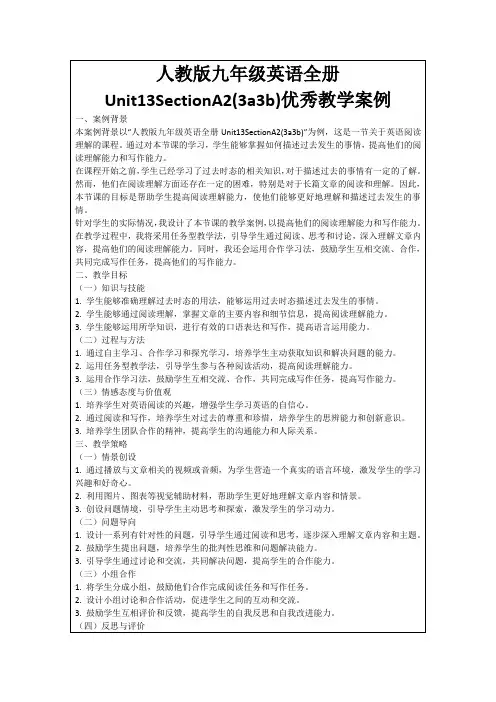

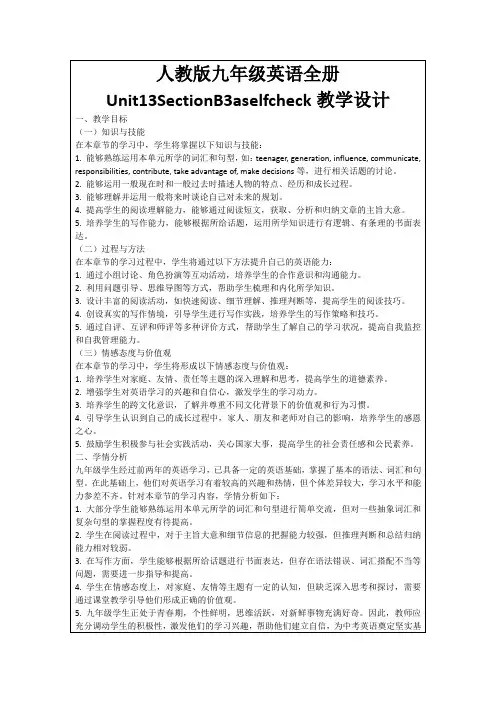
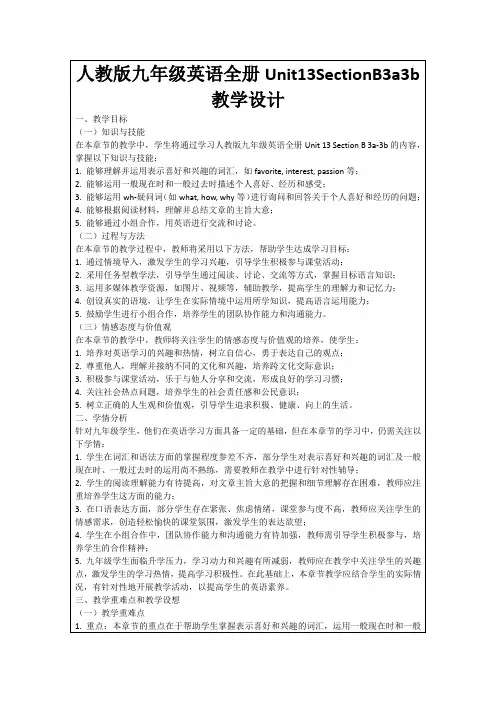

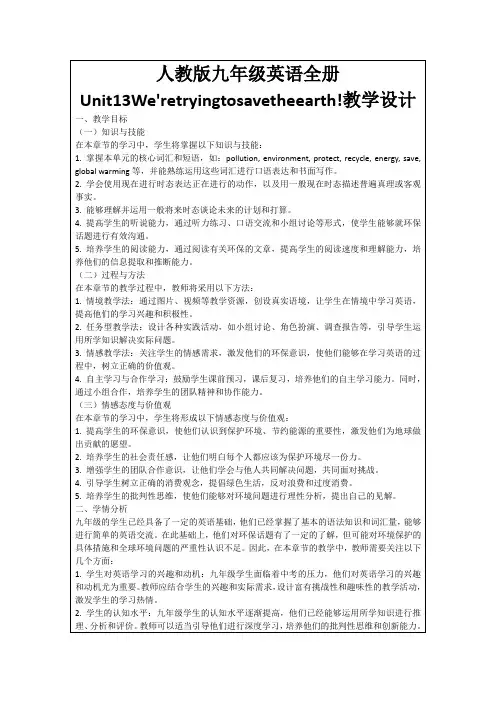
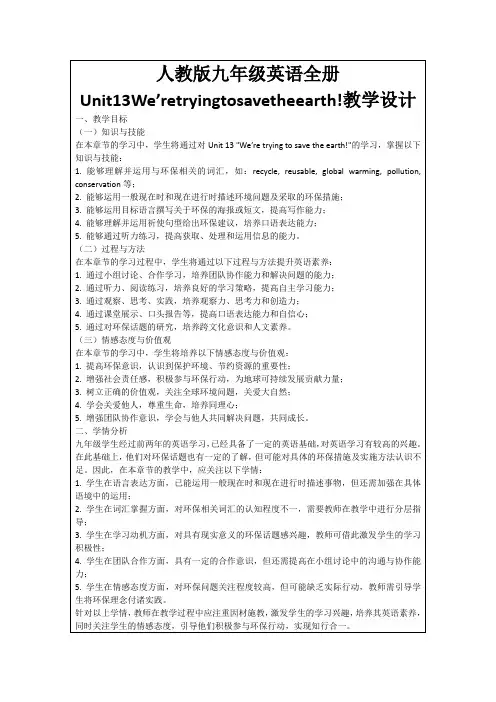
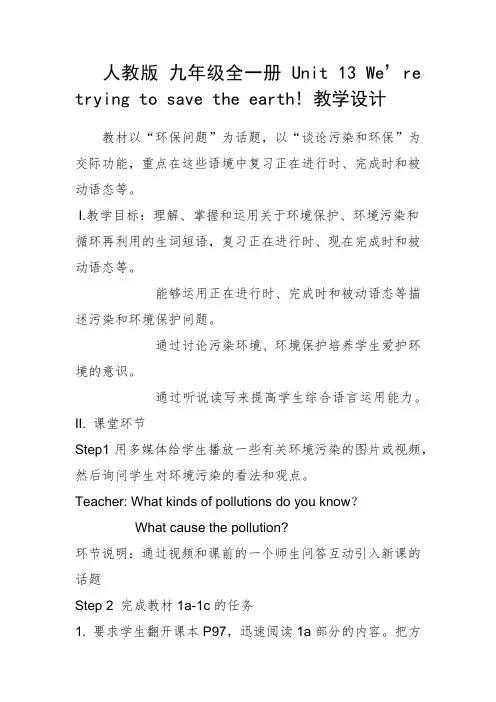
人教版九年级全一册 Unit 13 We’re trying to save the earth! 教学设计教材以“环保问题”为话题,以“谈论污染和环保”为交际功能,重点在这些语境中复习正在进行时、完成时和被动语态等。
I.教学目标:理解、掌握和运用关于环境保护、环境污染和循环再利用的生词短语,复习正在进行时、现在完成时和被动语态等。
能够运用正在进行时、完成时和被动语态等描述污染和环境保护问题。
通过讨论污染环境、环境保护培养学生爱护环境的意识。
通过听说读写来提高学生综合语言运用能力。
II. 课堂环节Step1用多媒体给学生播放一些有关环境污染的图片或视频,然后询问学生对环境污染的看法和观点。
Teacher: What kinds of pollutions do you know?What cause the pollution?环节说明:通过视频和课前的一个师生问答互动引入新课的话题Step 2 完成教材1a-1c的任务1. 要求学生翻开课本P97,迅速阅读1a部分的内容。
把方框中的单词按它们产生污染的类型写入相应的栏目中,并添加更多的单词。
2. 检查答案,先要求全班一起给出答案并检查讨论。
然后要求2-3名同学给出自己的答案,并把收集的答案列举在黑板上。
3. 要求学生听第一遍录音,并根据听到的内容完成课本上1b表格中的句子。
然后要求2-3名同学读答案。
(polluted, rubbish, fish Litter rubbish newspaper, stop, clean)4. 要求学生听第二遍录音,并逐句进行跟读。
5. 完成教材1c的任务,要求学生模仿1a内容,编造自己的关于污染的对话并进行对话练习。
并邀请2-3对同学当堂进行演示。
6. 小结训练。
要求学生在规定的时间内完成一个小练习。
并请若干学生给出自己的答案。
有错误的话及时解决纠正。
用所给词的适当形式填空。
1. There are many kinds of pollutions(pollute)in our daily life.2. All of the students should take part in keeping (keep) our school clean and tidy.3. Can you tell us your ideas for improving (improve) your spoken English.4. W e should stop using the wooden (wood) chopsticks toprotect the forest.5. Their grandparents were fishermen (fisherman) near the sea before they moved to the town.环节说明:通过学习1a,使学生对过去完成时态有所了解,并拓宽了思路;通过1b,锻炼学生的听力及抓取关键信息的能力;通过1c的训练锻炼学生的口头表达能力,同时巩固对本课内容的认识。
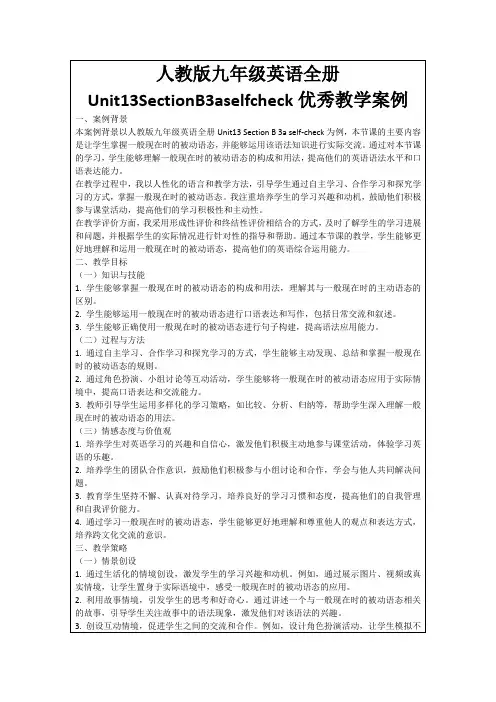
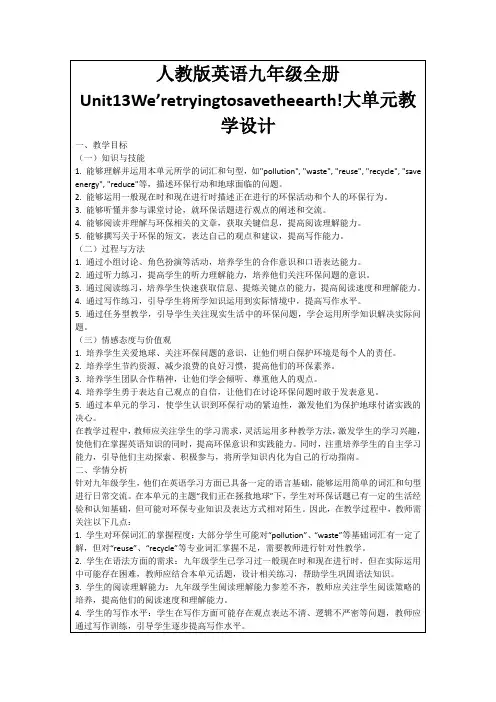
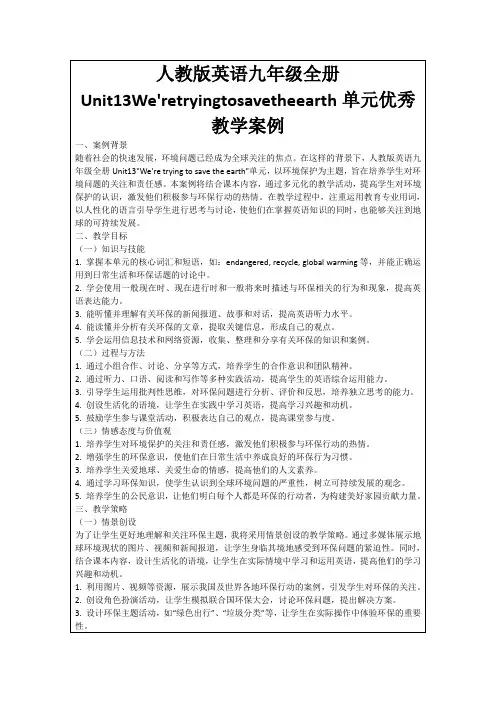
The Fifth PeriodⅠ.Teaching Aims and Demands1.Knowledge Objects(1) Key Vocabularyby accident, beverage, thousand, according, according to, ancient, legend, emperor, boil, fire, leaf , nearly, fall into, remain, notice, produce, pleasant, smell, taste, in this way, metal, pie, flying disk, bakery, Bridgeport, Connecticut , throw, special(2) The reading passage about tea.(3) The writing passage about the flying disk.2.Ability Objects(1) Train the students' reading skill on how to answer the questions.(2) Train the students' writing skill by writing an article.(3) Train the students' speaking skill.3.Moral ObjectsChina is among the leading countries in tea production in the world. Let's learn some history about the invention of tea.Ⅱ.Teaching Key Points1.The reading passage about tea.2.Lots of new words.3.The writing practice on the invention of the flying disk.Ⅲ.Teaching Difficult Points1.To teach the students so many new words in a single class.2.To help the students understand the reading passage.3.To direct the students to write the article.Ⅳ.Teaching Methods1.Understanding the passage by answering the questions.2.Doing writing practice by writing similar articles to the model one.3.Pairwork.Ⅴ.Teaching Aids1.Some real different kinds of tea and a real flying disk.2.A projector.Ⅵ.Teaching ProceduresStep Ⅰ Revision1.Revise the history of chips by asking the following questions;Were the potato chips invented by mistake?When were they invented ?Who invented the potato chips?How were the potato chips invented?2.Dictate the words below:sprinkle, chef, in the end, by mistake, potato chips, crispy, salty, sweet, sour, thin.3.Check the homework.Step Ⅱ 3aThis activity provides reading practice using the target language.First, show the new words in the reading passage on a screen by a projectorPoint to each word on the screen and teach the children to read it. Do it several times until the students can read each word correctly. Ask some students to read the words to the class to see if they can pronounce each word correctly.Ask the students to read the instructions together.Point to the title of the passage and say like this, showing a bag of tea to the class, we've learned the history of chips. Now there is a passageabout the invention of tea. Please read the article silently by yourselves now and write out the answers to the questions beneath the article.Read these four questions to the class:1.What is the article about?2.When was it invented?3.Who was it invented by?4.How was it invented?Tell them to read the article at least twice. They can try to catch the main idea the first time and answer the questions the second time. Tell them to circle any words or phrases that they don't understand.Ask four different students to read their answers to the class. Then ask some others to decide if their answers are right. Anyone in the class can provide his or her different answers to the class.Check the answers with the class.Then encourage the children to ask questions on the words or phrases that they don't understand. Ask other students to explain or define the new words in their own words, but make sure that they can be understood.Have the children correct their answers in writing and read the article loudly several times.Step Ⅲ 3bThis activity provides reading and writing practice using the target language.Ask the whole class to read the instructions together.Then show a real flying disk to the children and tell the children the name of the toy is a flying disk in English.You'll have to write an article using the notes in the box, The article will tell how the flying disk was invented. At first, let's go over the notes in the box. There are some new words.Go over the notes with the class. Point out the new words. Teach them to read and do some explanation at the same time. Make sure that all the students make everything in the notes clear.Then ask the children to look at the contents and the picture in the right box.Look at the picture in the right box. We can see a flying plate in the animal's mouth. And the title of the article has been given—From pie plate to flying disk. Also the first sentence has already been given to us. Let's read the title and the first sentence together now.Have the students read together.Find out how the writer combined the phrases in the notes into one sentence and try to say out the next sentence.Let them think for a while. Then ask several ones to say their sentences to the class. The sentences will vary, but have to be correct and meaningful.Then ask the children to make their own sentences with the notes given and note to say out the sentences in proper order to be an article. Let them work in pairs, listen to and help each other.After that, get the students to write their own articles. More around the classroom while they are writing, checking progress and offering help as necessary.Next, ask several students to share their articles with the class.Correct the mistakes they may have made.If time permits, get the students to work in pairs and check each other's article.This activity provides reading and writing practice using the target language.Read the instructions to the students.There is always something that we hate doing. For example, I hate cleaning the blackboard. What about you?Then ask some children to say the things they don't like doing to the class.After that, continue saying. Now please think of an invention that could help you. For me, I want to invent a self-cleaning board with something like a car's windsheld wipers. Then I would never need to clean the blackboard myself. What about you?Get the students to discuss the things they hate doing and the inventions that could help them. Let them work in pairs. Then call the children's attention to the chart on the right.Get them to look at the sample answer and try to complete the chart first.Ask some children to give their answers to the blanks of use and price. Such as, Use: to write tests instead of me by listening to me Price: one hundred yuan per penThen get the students to fill in the chart with the details of their own inventions. Don't review the task. It will be done in the next task.Step Ⅴ 4bThis activity provides listening and speaking practice using the target language.Read the instructions to the class.Get the students to ask and answer questions about their inventions in pairs first. Ask a pair to make a model conversation before the whole begin practicing.Ask several pairs to share their conversations with the class.Then tell them to look at the model conversation in the box.Then ask some others to share their presentations with the class.They have to state the reason for buying them.Then the class votes for the most popular invention they want to buy.Step Ⅵ SummaryIn this class, we've read an article about the invention of tea. We've also written an article about the invention of the flying disk. We've done much reading, writing. listening and speaking practice using the target language through groupwork.Step Ⅶ Homework1.Review the new words learned today.2.Rewrite the article—From pie plate to flying disk. Prepare to hand in it next class.3.Write out the presentation in activity 4 b.Step Ⅷ Blackboard DesignUnit 10 When was it invented?Section BThe Fifth PeriodAnswers to the questions in Activity 3a :1.The article is about the invention of tea.2.It was invented by the Chinese emperor, Shen Nong.3.It was invented by accident.Suggested answers for Activity 4a:Problem: writing testsNew inventions: a pen that listens and writesUse: writing tests instead of persons by listening to the ownerPrice: one hundred yuan per pen。